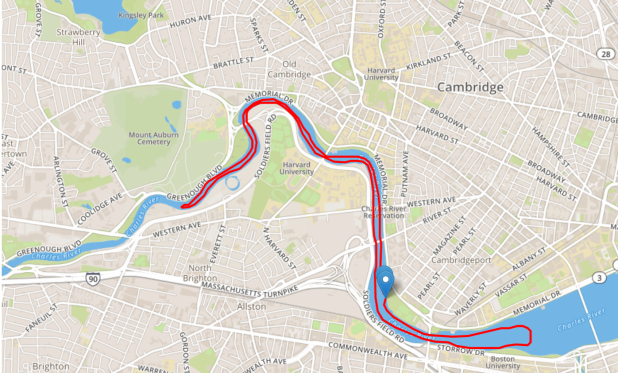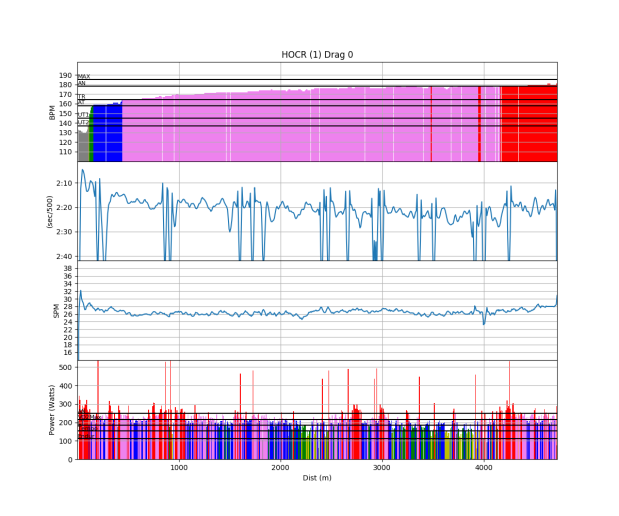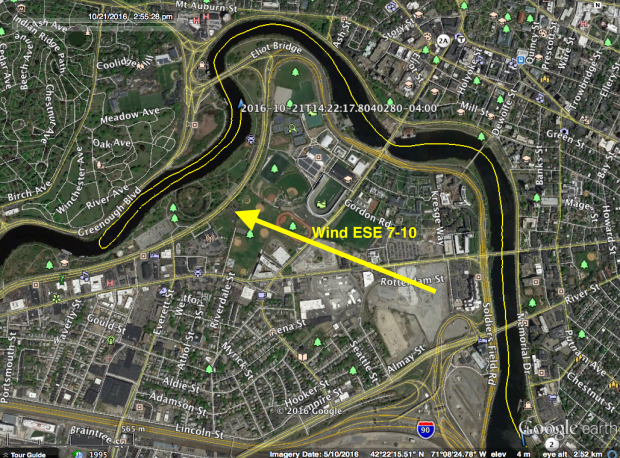The weather was perfect, my row was not. There are very few things as tiresome as moping about a race performance, so I won’t do that. However, there is a lot to learn from today’s race about fitness, training and other preparation and that starts with an honest review of how things went.
I’ve said it before and it’s still true. Even if you don’t have a good race at the HOCR, you have a good time. It is amazing to be part of something that big and to row on the same course, in the same event, with some of the finest athletes in the sport. And it is a real privilege to participate in such a professionally run and efficiently managed event.
So, let’s start with the results. I finished 42nd of 51 boats. I would have finished 39th on raw time, but I got well deserved penalty time for drifting off the course and missing three buoys. More about that later.
Let’s rewind to Friday. I brought my boat down to the launch area around 2:00PM on Friday afternoon, and by 2:30, I was on the course for a practice run.
It was windy as heck, and there was a ton of traffic, but it was a blast! It was warm and sunny, and despite a promise to myself to row nice and easy, I just couldn’t contain my excitement.
I was launching from the Singles and Doubles Launch area (SADL).

This is about 1000m from the start. On practice day, you join the traffic flow going up river. The whole river is buoyed to separate the upstream and downstream traffic lanes. Since the upstream lane is where the racing takes places, it is much wider and usually enables you to either use 2 of the 3 arches in most bridges. The return lane, on the Boston side of the river is generally single file and the traffic flow requires you to generally move at a light paddle pace.
On practice day, if you are in an eight or a quad, it’s not a great idea to go blasting up the river at full race pressure, but in small boats, you are generally pushing a little hard to just stay out of the big guys way as you go along. At least I felt that way.

In the summary plot, you can see the row up river from SADL to the finish line. Then the long, slow trip back down to the basin, then the quick dash through the start chute back up to dock.

Workout Summary - media/20171021-200303-Greg Smith 20171020 0240pmo.csv --|Total|-Total-|--Avg--|-Avg-|Avg-|-Avg-|-Max-|-Avg --|Dist-|-Time--|-Pace--|-Pwr-|SPM-|-HR--|-HR--|-DPS --|12017|71:10.0|02:57.7|136.8|20.3|151.1|173.0|08.3 W-|11643|68:22.0|02:56.2|135.4|20.3|150.6|173.0|08.4 R-|00376|02:47.0|03:43.4|124.2|19.3|145.9|173.0|05.8 Workout Details #-|SDist|-Split-|-SPace-|-Pwr-|SPM-|AvgHR|MaxHR|DPS- 01|03684|19:16.2|02:36.9|169.4|20.8|165.3|173.0|09.2 - practice 02|07174|44:46.8|03:07.3|116.9|19.8|143.7|168.0|08.1 - return 03|00786|04:19.8|02:45.3|174.7|22.9|155.9|170.0|07.9 - start to SADL
After I recovered my boat, I got it all covered and tied down for the night and went and got my registration packet. In the packet are four coveted items.
- Your bow number – which you get to keep
- Bib number – which goes on your back
- Sticky bow number label – which goes on your stern deck
- 2017 Head of the Charles Competitor sticker for your car window.
I am irrationally proud of the 3 competitor stickers on my car’s back window.
Then I headed home to try to relax.
Saturday – Race Day!
I slept pretty well for the night before a race, but I was up before my alarm at about 5:15am. I packed up my gear and headed in to the city. My event wasn’t until 9:06, but I like to get there really early to make sure I don’t have trouble getting a parking space, and that I have plenty of time to pace around nervously, visit the porta-potty twenty times, and chat with the other nervous rowers.
As dawn broke, the weather just perfect. It was warming up quickly, the sun was shining, and there was barely a hint of wind. It stayed that way for the whole weekend. Just amazingly good luck for late October in Boston.
I got more and more nervous as time crawled by, and by the time the first event had gone by, I decided to launch so I could take a nice long warmup to calm down and get my head clear. It was a very long warmup. Nearly an hour.

Most of it I paddled, but I did a few sets of SBR/sbr-feather/race pace bursts as I went along. My nerves stayed pretty jangly. I felt like I needed to take a leak, even though I had gone right before I launched, and my feet were feeling like I might get a cramp. Even my shirt tag was annoying the back of my neck. So, I have to find a way to better manage pre-race nerves.
When we were about 15 minutes before our race, they called us up to the area behind the chute, and there we stayed. We were packed in bow to stern in two lines, one even and the other odd. You basically had to hold water and take the odd stroke to keep from drifting into each other, but it really raised the stress level.
Finally, they started the event. I was bow number 22, so, I was listening to the first 10 or so racers called onto the course while still packed in. Then the pack loosened in front of us and we started paddling down the chute. At the point in time where they started the guy two people in front of me, I noticed, to my horror, that my speedcoach had turned itself off. I later researched why and found that when I loaded the new firmware, the default for “auto off” is enabled and i didn’t take enough strokes in the chute to keep the thing alive. So, I’m starting in about 10 seconds and my speedcoach is off.
I had two competing thoughts. First was to just concentrate on rowing the race and forget about the speedcoach. This had a certain romantic attraction, but a couple of important downsides. First, I wanted to row to a target power to avoid torching myself too early in the race. Second, I like having my HR visible so I can tell the difference between really being on the edge, and just being a wimp about pushing myself. So, after a 2 stroke debate, I leaned way forward and tried to turn on the speedcoach. Of course, my first attempt failed. My second attempt worked. A couple more strokes while it turned on, then lean way forward to start it recording. This also took two attempts.
By this point, I was literally two strokes away from the starting line. I focused on putting on pressure and rowing cleanly and didn’t notice that in all that screwing around I had totally lost my point and my angle was way off going through the start line. I noticed that I was close to the boston end of the start line, but I didn’t realize that my point was so off until the first course marker surged by on the WRONG SIDE OF MY BOAT. That woke me up and I immediately corrected my steering, but not quickly enough. Before I had fixed it, I missed two more buoys. I had piled up 25 seconds of penalties in the first 10 seconds of the race.
Well, nothing to be done about that. Time to focus on the race.
I noticed that the guy in front of me was not pulling away, and might even be getting a bit closer. That’s a good thing. Then I noticed that the two guys behind me were definitely gaining and that was not a good thing.
A quick glance at the speedcoach showed that I was pushing pretty damn hard. My pace was a lot closer to 2:10 than 2:15 and my power was up around 240. I needed to settle down and stick to my 210-220W game plan.
My steering was abominable. By putting myself on the Boston side of the course, I was on the outside of the curve around Magazine beach. I managed to close the distance on bow 21, even though he had the better inside line. By the time we reached the SADL docks at about 5 minutes in, I was nearly overlapped with him and had pushed a lot closer to the right line.
Then he decided to yield the inside line to boat 23 that was coming up fast. So he cut across my bow and I was rowing side by side with #23 for a few strokes. We had a quick clash of oars, and he pushed ahead. I decided to stick to the cambridge arch of the river street bridge. I saw that #24 was coming up and I didn’t really want to be yielding the line under the bridge.
I annotated the path I took with the best straight line segments, you can see the extra length from being on the outside at first and the weaving around.

Between the River Street Bridge and the Western Ave bridge, boat 24 passed me. We both passed through the center arch of the Western Ave bridge. By this time, I was getting pretty fatigued. My heart rate was up to 176 by this point, and it’s clear from the metrics that this fatigue was impacting the quality of my rowing. My effective length had decreased, and I looked pretty labored.
My line to the weeks bridge was actually pretty good. Coming out of it. I should have cut harder for Anderson, and then I turned a bit too far, but it wasn’t so bad. I had turned down the power a bit and my HR, which had peaked at 180 came back down into the high 170s. My pace also dropped.

Coming out of Anderson is a tough spot on the course. Up to that point, you have the distraction of all the bridges to keep your mind occupied. Now you have a long straight section to get to the apex of the big Eliot curve. And then after that, a lot of starboard pressure to keep you on track around the curve. By this point, I tried to pull down the stroke rate a little bit to focus on rowing more efficiently, but it doesn’t show up in the data. I also meandered a bit around the proper course on the way to the apex, costing me more time.
As I was approaching Eliot, there was a rower overtaking me on the inside of the curve. I allowed him to push me toward the Cambridge shore as we approached the bridge and I actually lightly scraped my starboard blade on the bridge arch because I misjudged how close I was to it by about 6 inches. Coming out of the bridge, I was in the perfect place, right up next to the nobles docks for the last big turn.
But I didn’t hug the turn tightly enough. I drifted a bit out and rowed more distance again. Even on the final push to finish, it looks like I got sucked into following the cambridge shoreline.


Workout Summary - media/df_20171024-161339.csv --|Total|-Total-|--Avg--|-Avg-|Avg-|-Avg-|-Max-|-Avg --|Dist-|-Time--|-Pace--|-Pwr-|SPM-|-HR--|-HR--|-DPS --|04722|21:57.0|02:19.5|214.2|26.5|172.5|181.0|08.1 W-|04722|21:58.0|02:19.6|213.9|26.5|172.6|181.0|08.1 R-|00000|00:00.0|00:00.0|000.0|00.0|000.0|181.0|00.0 Workout Details #-|SDist|-Split-|-SPace-|-Pwr-|SPM-|AvgHR|MaxHR|DPS- 00|00500|02:11.2|02:11.2|244.1|27.2|153.5|165.0|08.4 01|00500|02:18.4|02:18.4|233.7|26.0|166.8|170.0|08.3 02|00500|02:18.8|02:18.8|218.2|26.1|170.5|172.0|08.3 03|00500|02:18.7|02:18.7|218.1|26.1|173.1|175.0|08.3 04|00500|02:20.7|02:20.7|184.4|26.4|174.9|176.0|08.1 05|00500|02:23.1|02:23.1|226.8|26.8|176.3|177.0|07.8 06|00500|02:20.6|02:20.6|200.3|26.5|177.2|179.0|08.1 07|00500|02:26.3|02:26.3|163.7|26.2|177.5|179.0|07.8 08|00500|02:18.7|02:18.7|236.3|26.8|178.7|180.0|08.1 09|00222|01:01.6|02:18.8|223.6|28.1|180.2|181.0|07.7
To look at the Flex Charts click here
Let’s start with the good stuff.
- I managed to recover from a back injury and get about 3 weeks of serious prep work done before the race.
- I knew that I was going to underperform and I went and raced anyway. My pride almost stopped me and that would have been a huge shame. I would have regretted not being out there. Despite my negative comments, it was a blast.
- I passed somebody.
- My line from River Street to Anderson was better than last time.
- I put everything into the row.
- I used power and heart rate feedback to manage my pacing
Now onto the criticisms, and lessons learned.
- Even before I was injured my training was not consistent. I tried to train for a long open water row that I ended up having to scratch from because of business travel and my motivation suffered from that. I think my power on the erg is probably 20 to 40 watts lower this season than in 2015.
Lesson learned: With my work schedule, I think I need to restrict my competing to just head races, and plan my schedule around that. I need to maintain a strong aerobic base as the highest priority. I need to keep my training plans simple. - I had equipment problems right before the start. This was caused by a firmware update having an unexpected issue before the start.
Lesson learned: Change nothing in the week before the race. - I went off course and got 25 seconds of penalty time. This was caused by losing situational awareness due to the equipment problem. Another cause was not having enough time on the course to be able to “feel” where I was. Yet another cause was rowing without a mirror. I had planned to learn to use a mirror this season, but didn’t follow through.
Lessons learned: Take the time to double my course at the start. Learn to use a mirror. More practice runs on the course. - I did not follow an ideal line on magazine beach, approaching River Street, in the stretch from Anderson to the Eliot turn and right at the end. This probably added about 100m to my row.
Lessons learned: More practice on the course. Use a mirror - My rowing technique was sloppy. I immediately fell back into the habit of letting my knees fall open at the catch. My finishes were slow and inconsistent.
Lessons learned: I did not spend enough time in my boat this season. I did do any side video to look at my stroke. I weigh 20 pounds too much. I have an imbalance between left and right side that you can see as inconsistent knee heights.
As Paul Simon says in one of his songs…”So watcha gonna do about it, that’s what I wanna know”
Here’s the plan.
- Fix my imbalance: I have had one appointment with a Physical Therapist and I will need to follow through on that and have him help me define a core training routine to maintain balance.
- Fix my weight: This is just purely discipline. I haven’t figured out the plan yet, but it starts with portion control, and reducing carbohydrate consumption. The main thing is I have to start weighing myself daily and tracking it.
- Get a coach: I’ve contacted Marlene Royle to start getting remote coaching. I think this will work out best since my schedule is so irregular. I may want to supplement it with some live coaching from someone to help make sure that my boat rigged right for me.
- Do multiple head races next season: I think 3 is a good number. It is a bit of a challenge to race because it takes a big bite out of the weekend, and limits the amount of time that my wife and I can spend down on Cape Cod. So, more than 3 will definitely be too many. 3 is probably OK.
- Get back to what works in training. That means going back to lactate testing and using it to set training intensity. It means a simple polarized plan with guidance from Marlene. It means regular testing to keep myself honest, motivated and to correct things as I go along. It means 80 minute endurance sessions.
- I need to increase the effectiveness of the time I spend in my boat. There were three things keeping me out of my boat. Business travel, time on the cape, and equipment issues. I can’t control business travel. When I am on the cape, I can usually do open water rowing and I think that actually helps with balance. And hopefully I won’t randomly break a rigger 28 days before a major race. And hopefully, it won’t take until 11 days before the race to get everything fixed. But since all of that stuff is not in my control, I think that I need to make sure that there is a specific technique section in each OTW session. I can do it as part of warmup and cooldown, but I think I need to do more of that and also include more video feedback.
It is likely that I won’t get a HOCR bid in a single next year, but I will enter the draw for both singles and doubles. If I don’t get in either, then I will do other races and get ready for the following year.
In some ways, this race has helped me really clarify my thinking. I’m ready to make changes and pursue this in a much more process oriented way. I’m looking forward to the structure and the work required.
Ugly videos coming soon.




























